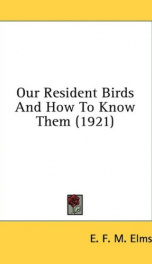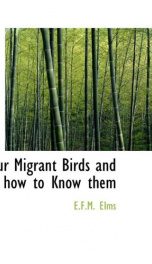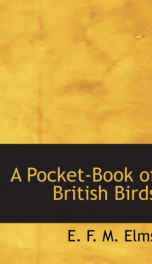our resident birds and how to know them

INTRODUCTION THIS book has been written and compiled to enable the reader to know our feathered friends on sight. Those who have made a study of birds can, by the exercise of trained observation, recognise them by their distinctive habits, language or peculiarity of flight. For the uninitiated, however, a simple and practical means of immediate identification is required. After careful consideration, I have come to the conclusion that the most satisfactory plan of arrangement is First, to group the birds under their main habitats, as follows I. Birds of the gardens, orchards and cultivated districts. 11. Birds of the woods and well-wooded districts. III. Birds of the commons, downs, moorland and mountainous districts. IV. Birds of the streams, rivers, lakes and marshy districts. v. Birds of the sea, seashore and cliffs. Secondly, sub-divide these groz s under A Colour. B Size. By this simple scheme it will be an easy matter for the observer to identify birds seen in the garden or in the course of a country walk. Naturally there are exceptions to the general scheme woodland birds may occasionally visit gardens, for instance, but such cases are obvious in themselves, and do not affect the general arrangement. 7 8 INTRODUCTION My aim has been to formulate tables which may put one on the right track then, by a process of deduction from the fuller information given in the body of the book, to identify the bird beyond doubt. London. E. F. M. ELMS. HOW TO USE THIS BOOK WHEN seeing a bird you do not know, first of all make a mental note of your environment. This will decide which of the five Habitat Headings you should look under. At the same time try and visualise the colourappearance of the bird, and also its size-whether small, medium or large. Then turn to one of the appropriate Tables-see pages 12 to 14-and you should without much difficulty be able to place your bird or at any rate find a clue to its identity. If at this stage you are not convinced as to the species turn to the body of the book and read carefully. In addition to noting its colour and size, you may have observed some characteristic habit, in flight, gait or language, and reference to such will be found which will enable you to settle the question. To take an example of one of our commonest birds Habitat-the garden. observed a black-looking bird of medium size on the lawn. Consult table of Resident Birds of the Garden, etc. Look under column Black or dusky-medium, a cl you will find blackbird or starling. You saw one or other of these two birds. Consult both blackbird and starling in the body of the book, and you should rapidly be able to decide which of these two birds you saw. Repeat the process with any other birds you may see and wish to know, and with careful observation and scrutiny of the tables and information in the book you will soon find yourself readily able to identify the species. 9 B LIST OF CONTENTS Page RESIDENTB IRDS O F the Garden, Orchard and Cultivated Districts - - - - - - - 7 RESIDENT BIRDS OF the Woods and Well-Wooded Districts - - - - - - 45 RESIDENT BIRDS OF the Commons, Downs, Moorland and Mountainous Districts - - - - 66 RESIDENTB IRDS OF the Streams, Rivers, Lakes and Marshy Districts - - - - 80 RESIDENTB IRDS O F the Sea, Seashore and Cliffs - 96 TABLE I.-RESIDENT BIRDS OF THE GARDEN, ORCHARD AND CULTIVATED DISTRICTS.-Chapter I... --This text refers to the Paperback edition.
Info about the book
Author:
Series:
Unknown
ISBN:
0618002103
Rating:
4/5 (1)Your rating:
0/5
Languge:
English
Users who have this book
Users who want this book
What readers are saying
What do you think? Write your own comment on this book!
write a commentif you like our resident birds and how to know them try:
Other books by this author
Do you want to read a book that interests you? It’s EASY!
Create an account and send a request for reading to other users on the Webpage of the book!



